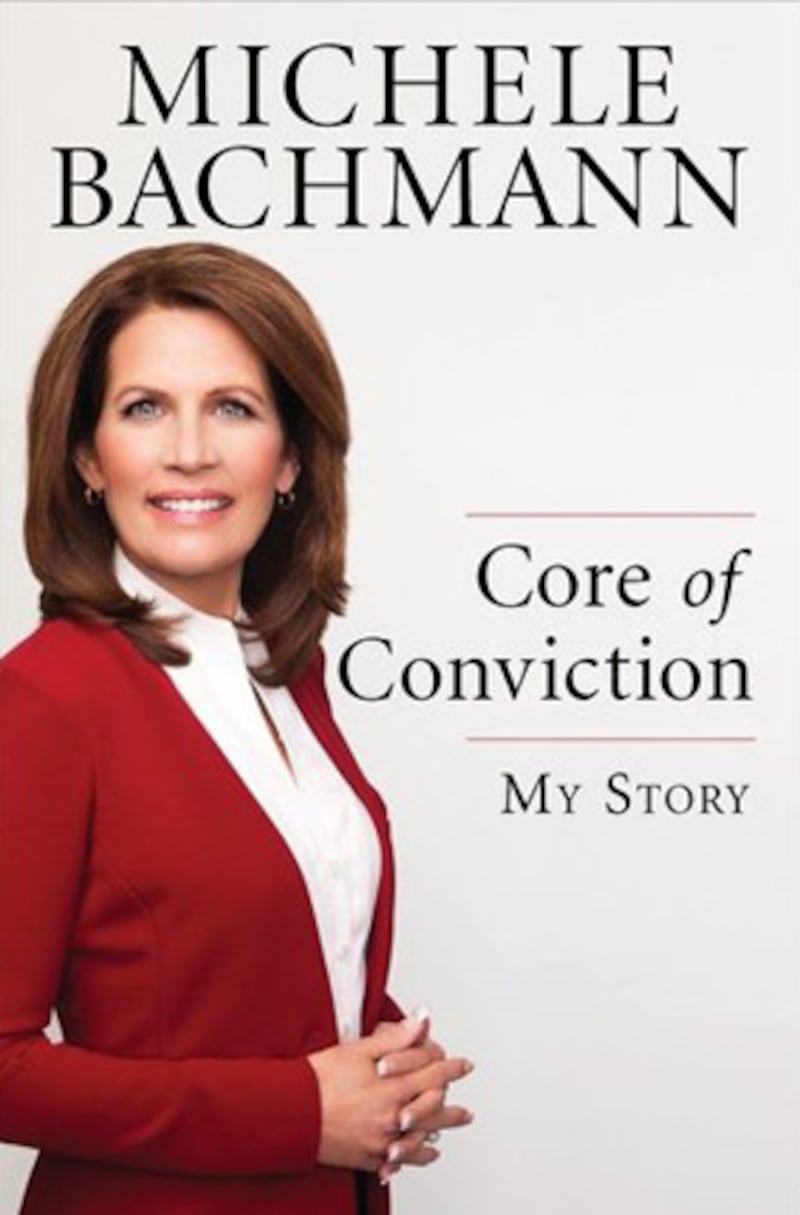It seems like a political lifetime since Rep. Michele Bachmann announced in June that she was writing a memoir. Back then, her star was rising rapidly; today, she’s just another of the many former Romney alternatives in the GOP field. Her book, titled Core of Conviction and released Monday, could provide a much-needed boost to her struggling campaign. We speed-read the book and picked out the best bits.
Not Quite the Whole Truth
Bachmann has been criticized for stretching the truth in the past, and she won’t escape such charges in the book. The first instance comes right at the start. Bachmann opens by explaining how her political career began after she decided to attend the district Republican convention on a whim. When a group of activists decided they needed to run a candidate against the increasingly moderate incumbent state senator (his name was Gary Laidig; oddly, she never names him), she was chosen, despite her lack of political experience and the jeans she was wearing. To her surprise, she won—setting the stage for her career in the state senate, the U.S. House, and eventually for a presidential run. Every successful candidate needs a compelling foundational myth, and this surely fits the bill. The only problem? It’s more myth than foundation. As various commentators have pointed out—starting with the doggedly adversarial blog Dump Bachmann—she already was a political activist by that April day. It’s not the only distortion. Describing a charter school that she and her husband, Marcus, helped to found, she derides critics who claim the school was overtly religious. “Yes, we were Christians, but we never sought to impose Christianity on our students,” she writes. The liberal magazine Mother Jones turned up documents showing that the school’s superintendent ran it using “20 key principles of Christian management;” when the school’s doctrinal focus was challenged, she and her husband stepped down. It’s hard to square all that with something she writes early in the book: “When I say something wrong, I’m hard on myself, because I’m trying to communicate information accurately. I’ve learned the hard way at the national level that any erroneous statement will very quickly be magnified. So, as someone who talks for a living, I’ve learned to check, double-check, and triple-check my sources. And yet I still make a mistake or two!” Few will argue with her last point.

Marcus, Marcus, Marcus, Marcus, Marcus
Although Bachmann is the protagonist of her book, her husband is seldom far from view. She writes effusively about her first meeting with him, their romance, and the symbiotic codependence of their relationship—often in touching detail. She drops some entertaining details—like the fact that she gave the suit he wore to their wedding away to Goodwill (she never liked it, she says—it was dark blue velour, but “hey, this was the seventies!”). And she talks about the importance of being an obedient wife, including her decision to leave law school at Oral Roberts for a spell because Marcus was unhappy in Tulsa. But if you want to read about more controversial aspects of Mr. Bachmann’s career, including the allegation that his counseling practice offers “pray-away-the-gay” therapy, you’ll have to look elsewhere.
The Childhood of Michele Amble
Some of the most moving scenes come from Bachmann’s recollections of her childhood in Iowa. Her family had modest means; things improved when they moved to Minnesota, but her parents’ divorce later on marked young Michele Amble deeply. “I will always honor both my father and my mother, but the fact remained that our family was irretrievably broken,” she writes. In another episode that’s less serious but must have been plenty traumatic for a teenager, she reveals that she wasn’t asked to either the junior or senior prom—a surprising turn for an adult whose looks have sometimes garnered unwanted attention.
Free-Associative Writing
Though Bachmann is sometimes criticized for misspeaking or making extreme statements, her ability to keep the conversation on her pet issues is an important part of her political success. In book form, that talent for turning any anecdote into a talking point produces some jarring juxtapositions and odd free associations. For example, she dubiously traces her critique of Social Security to a conversation between her grandmother and father when she was 8 or 9 years old. Elsewhere, she begins talking about the tendency of Republicans in the Minnesota legislature to moderate their views. That turns to a mention of how she respected Sen. Paul Wellstone, the outspoken liberal Democrat, because his convictions were strong, even though she disagreed with most of them. From there, we move on to the plane crash in which he died, then the 9/11 attacks, then her admiration for President Bush’s resolute response to them. After that dizzying digression, she turns right back to her time in the state legislature again.
The Driving Force for Her Campaign
Bachmann’s strong religious views are well known, as is her story of becoming an evangelical Christian as a teenager, and those stories reappear here. But God isn’t just an inspiration for her life—he’s also the inspiration for her campaign. She explains that she decided to run after praying at length with her husband. “As Proverbs tells us, we can make our own plans, but the Lord gives the right answer,” she writes. “I sensed an answer. I knew what I was being directed to do. I was called to serve.” (She doesn’t address what a defeat would indicate about her divine backer’s favor.) But Bachmann often seems to indicate a stronger affinity for the Old Testament than the New. Perhaps most intriguingly, she twice mentions the relatively minor Hebrew prophet Nehemiah, whom she praises for rebuilding the walls of Jerusalem—perhaps a dog whistle to the evangelical Zionist right as much as anything.
Bachmann’s Political Record
As with many political books, a large chunk of the text is devoted to recounting a spit-polished version of the candidate’s record. Bachmann’s been criticized for her short record as a tax attorney and her thin list of legislative accomplishments. She dispenses with the first by telling a good anecdote about the excessive complexities of the tax code, and the second by talking about her campaign against federal light-bulb efficiency laws. There’s a lengthy critique of the health-care reform bill passed in 2011, and she is particularly critical of the bill’s failure to contain costs—a viewpoint shared by many experts on both sides. But she spuriously suggests that tort lawsuits, rather than ballooning administrative costs, are to blame for the skyrocketing cost of health care in the United States, and she doesn’t indicate clearly whether she favors expanded coverage for the poor or how she’d provide it, hiding behind the standard conservative refrain of leaving it to “market forces.” Her oddest moment of wonkery, however, is in discussing Goals 2000, an education bill that preceded No Child Left Behind, and is now mostly forgotten. The plan even gets an appendix, the only one in the book.






